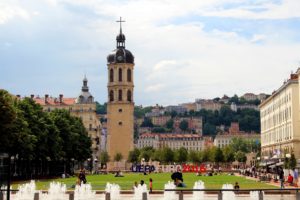Lyon France Ideal for Historical Vacation
Regarded as the silk capital of the world throughout the centuries, the city of Lyon, France possesses many intriguing characteristics with regard to both history and tourism. Located in France’s Rhone-Alps region, Lyon is situated in the east-central section of the country and is close to both Paris and Marseille. According to the GeoNames geographical database, Lyon has a population of approximately 475,000.

An Interesting History
Initially established as Lugdunum–a Roman settlement–in 43 BC, the city quickly became a primary location for trade. Its convenient location by the Saone and Rhone rivers allowed the area to serve as the capital of the Gaul region and the city continued to flourish even after the Roman Empire collapsed.
Lyon held a primary commercial role during in the Industrial Revolution and continues to be one of the primary commercial centers of France. Once occupied by both the Nazis and the Resistance Movement, the memory of those who fought for the liberty of their country during WWII is honored in a number of sites throughout the city.
Unique Attractions
Lyon is arguably most renown for its Festival of Lights, which occurs each December over a four day period, typically around the first weekend of the month. Throughout this time, impressive light installations by locally famous architects and artists illuminate commercial buildings all around the city. In addition, residents decorate the city’s streets with lanterns made from candles and paper bags. This attraction draws millions of spectators from all around the globe and is Lyon’s most celebrated event.
Lyon is also famous for its secret pathways–also called traboules–which are indoor passages originally used to transport silk products in the 18th and 19th centuries. They were also used during Nazi occupation in WWII by Resistance fighters. There are some who believe the secret passageways were responsible for stopping Hitler from gaining complete control of Lyon during Nazi occupation. The traboules have now become a popular tourist attraction and over forty of these intriguing passageways can be explored by the public free of charge.
Trade and Industry
Lyon is a primary center of trade and business and is also known as France’s capital of gastronomy. Lyon is regarded as the center for biotech, pharmaceutical and chemical industries in France. In addition, the city’s role in the world’s logistics, software and electronics industries is increasing. As previously mentioned, the city of Lyon played a major role in the world silk trade throughout history. Its partnership with Italy regarding the silk trade can be seen in the strong Italian influence of some of Lyon’s architecture. Tourism is also a major industry in Lyon as well and the city welcomes millions of visitors each year.

Weather
With mountains blocking the Mediterranean sea’s moderating effects and encouraging precipitation and humidity from the valley, Lyon features more extreme temperatures than many other regions of France. However, summers are quite pleasant with temperatures ranging from 70-82 degrees Fahrenheit. Winters typically feature moderately cold weather with lows in the 40s and temperatures can vary as much as 25 degrees from day to night. July is the sunniest month of the year in Lyon, featuring up to ten hours of sunshine each day and the city’s rainiest month is September.






Leave a Reply